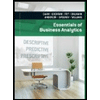
1.
To record: The necessary transactions for Company DRS on each date.
1.
Answer to Problem 5.2BP
Journal entries for the Company DRS:
| Date | Account Title and Explanation | Debit ($) | Credit ($) | |
| June 16 |
| 2,700 | ||
| Service revenue (2) | 2,700 | |||
| (To record services provided on account) | ||||
| June 20 | Sales allowance (3) | 810 | ||
| Accounts receivable | 810 | |||
| (To record sales allowance for services on account) | ||||
| June 30 | Cash (4) | 1,890 | ||
| Accounts receivable | 1,890 | |||
| (To record receipt of cash on account) | ||||
Table (1)
Explanation of Solution
On June 10:
No entry is required because Person R crashes the hard drive and sends to the Company DRS.
On June 12:
No entry is required because after initial evaluation Company DRS emails Person R to let him know that full data recovery will cost $3,000.
On June 13:
No entry is required because Person R informs to Company DRS that he would like them to recover the date and that he is a student at UCLA, qualifying him for 10% educational discount and reducing the cost by
On June 16:
- An increase in accounts receivable (asset account) is debited and,
- An increase in sales revenue (
stockholders’ equity account) is credited.
Working notes:
On June 19:
No entry is required because when Person R receives the hard drive he notices that Company DRS did not successfully recover all data. Where approximately 30% of the data has not been recovered and he informs to Company DRS.
On June 20:
- An increase in sales allowances (stockholders’ equity account) is debited and,
- A decrease in accounts receivable (asset account) is credited.
On June 30:
- An increase in cash (assets) it is debited and,
- A decrease in accounts receivable (asset account) is credited.
Determine the amount of cash received from Person R:.
2.
To show: Company DRS net revenues in its income statement
2.
Explanation of Solution
| Company DRS | ||
| Partial Income Statement | ||
| Particulars | Amount($) | Amount ($) |
| Total service revenues | $2,700.00 | |
| Less: Sales allowances | (810) | |
| Net service revenues | $1,890 | |
Table (2)
Hence, Company DRS net service revenues are $1,890.
3.
To Calculate: Net revenues if Person R had paid his bill on June 25.
3.
Answer to Problem 5.2BP
| June 25 | Cash | 1,852.2 | ||
| Sales discounts (5) | 37.8 | |||
| Accounts receivable (4) | 1,890 | |||
| (To record receipt of cash on account) | ||||
Table (3)
Explanation of Solution
On June 25:
Services rendered on June 20 and the payment is received on June 25. Here Person P make payment on its 5th day from the date of service received. Hence, Person P is eligible to get a sales discount of 2%. Thereby, Company DRS must have received its receivables after deducting the sales discount of 2%. This transaction increases cash, sales discount and decreases accounts receivable. Increase in cash (asset account) is debited, increase in sales discount (decrease in stockholders’ equity account) is debited, and a decrease in accounts receivable (asset account) is credited.
Working note for journal entry made on June 25:
Determine the amount of sales discount.
| Particulars | Amount($) | Amount ($) |
| Total service revenues | $2,700.00 | |
| Less: Sales allowances | (810.00) | |
| Sales discounts | (37.80) | |
| Net service revenues | $1,852.20 |
Table (4)
Hence, Company DRS net service revenues are $1,852.20 if Person R pays his bill on June 25.
Want to see more full solutions like this?
Chapter 5 Solutions
Financial Accounting
- Can you solve this general accounting question with accurate accounting calculations?arrow_forwardWhich statement is correct? Question 6 options: A simple capital structure excludes potentially dilutive securities. A simple capital structure includes potentially dilutive securities. EPS applies only to a company with a simple capital structure. A company with a simple capital structure does not need to calculate EPS.arrow_forwardCan you solve this general accounting question with accurate accounting calculations?arrow_forward
- Which statement is correct about hedge accounting? Question 5 options: Hedge accounting must be reported in profit or loss. It permits the hedging item and the hedging instrument to be recorded in the same way. The financial effects of the hedging item and instrument offset 100% in hedge accounting. Hedge accounting must be reported in OCI.arrow_forwardaccounting?arrow_forwardI need the correct answer to this general accounting problem using the standard accounting approach.arrow_forward
- I need help solving this general accounting question with the proper methodology.arrow_forwardWhich of the following is an example of a "warrant"? Question 3 options: Commitment to buy 100 barrels of oil next month at $125/barrel. Commitment to buy $100,000 U.S. dollars in 4 months at US$ = 1.10. Right to buy 100 shares of CIBC at $50.00 per share over the next 5 years. Pay interest at prime +3% in exchange for receiving interest at 5%. Previous PageNext Pagearrow_forwardWhat is a "put" option? Question 2 options: A contract that gives the holder the right to sell an instrument at a pre-specified price. A contract that gives the holder the right to acquire an instrument at a pre-specified price. A contract that gives the holder the right to buy or sell something at a specified price. A contract that is derived from some other underlying quantity, index, asset or event.arrow_forward
- Please explain the correct approach for solving this general accounting question.arrow_forwardI need guidance in solving this financial accounting problem using standard procedures.arrow_forwardWhich of the following is correct about financial instruments? Question 1 options: Accounting for financial instruments has been consistent. All financial instruments are accounted for at fair value. There is no economic substance to financial instruments. They may be used in support of innovations designed to circumvent accounting standards. Previous PageNext Pagearrow_forward
 College Accounting, Chapters 1-27AccountingISBN:9781337794756Author:HEINTZ, James A.Publisher:Cengage Learning,
College Accounting, Chapters 1-27AccountingISBN:9781337794756Author:HEINTZ, James A.Publisher:Cengage Learning, Essentials Of Business AnalyticsStatisticsISBN:9781285187273Author:Camm, Jeff.Publisher:Cengage Learning,
Essentials Of Business AnalyticsStatisticsISBN:9781285187273Author:Camm, Jeff.Publisher:Cengage Learning,



